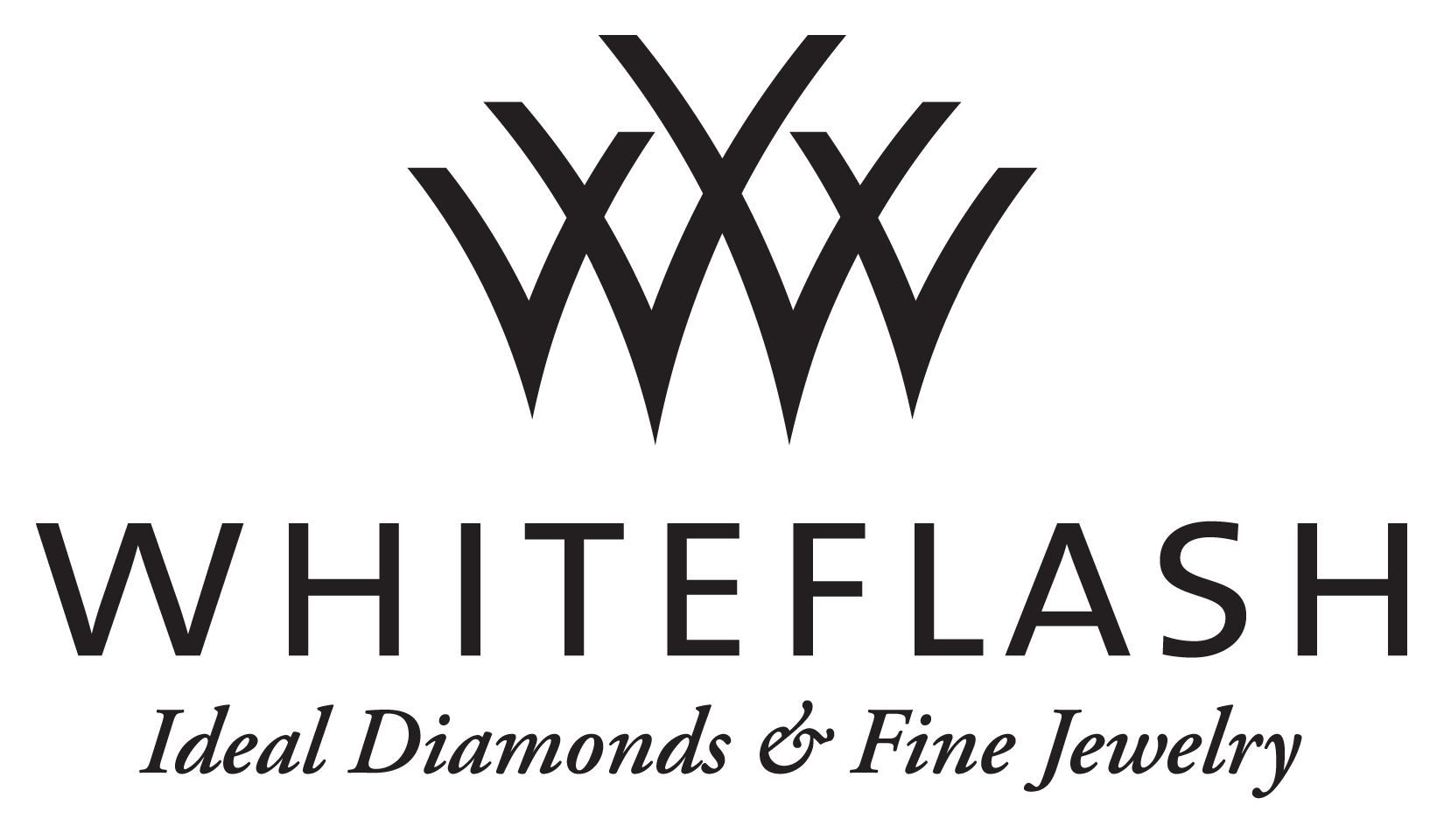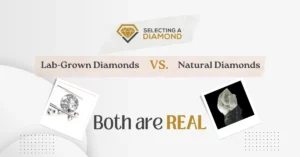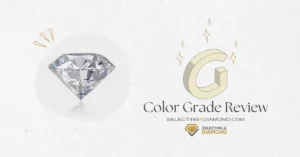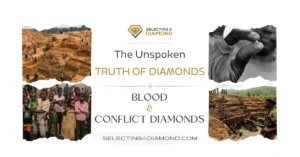Summary in a few line:
We all want a diamond that doesn’t look yellow, but not all of us know that in order to get a colorless (to our eyes) diamond, we don’t necessarily go to colorless grades (D-F), as the next group (near colorless) can offer a great range of colorless diamonds, at much better prices.
Check this stunning diamond on James Allen and see yourself, or this clean pick on Blue Nile, if it didn’t say it has H color, would you really notice?
That’s why we always recommend starting with H color for various of reasons that will be discussed in this article.
In a nutshell, picking either an H or G color diamond will be a great choice for everyone, don’t go crazy with higher color grades since you will be paying a fortune for something you (or anyone) can’t see.
Where G H Colors Set on Color Grade Chart?
It’s important to note that there are many characteristics grades, mainly the Color Chart, the Cut Chart, the Clarity Chart, and not lastly the Carat Chart. We took the liberty to explain each of them in detail on our blog. Feel free to check them out.
For this post, we will briefly go over the color chart.
GIA, the Gemological Institute of America; the creators of the 4Cs have created a diamond color chart that clearly indicates how the diamonds are graded based on their colors. More accurately, based on how much yellow the diamond holds.
You should know that many adjacent color grades might cause some confusion when looking at (hard to differentiate with the naked eye).
As per the below chart, you can clearly see that you have 4 groups, each group has a number of color grades that differentiate them from grades in other groups.
However, we won’t be going deep in this topic here; since we already have an ultimate full guide for that, but in short:
When GIA graded colors in the early 1950s, they managed to distinguish between each color grade and the next one as much as possible.
Then, they grouped color grades into 5 separate subcategories: Colorless starting with D to F, Near Colorless (G-J), Faint (K-M), Very Light Yellow (N-R), and Light Yellow (S-Z).
Is a jump between a grade to the next one the same?
There’s a noticeable difference between diamonds in different groups. We also feel it’s necessary to mention that diamond color difference is slightly higher for diamonds in different groups than diamonds in the same group!
For instance, a diamond with an F color to another with G is a bit more than the difference between G & H.
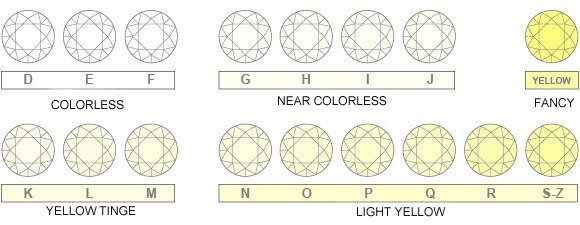
While this might sound straight-forward, it’s important to understand that no one EVER can look at a diamond and say: “Oh this looks like an H-colored diamond, why didn’t you get a G?!”
Why People Get Confused & Hesitant Mentioning H & G Colors?
You probably heard from a jeweler or a salesperson something like this:
“EVERY upgrade from a color grade to the next one is a big upgrade and can be spotted, and is worth every penny!”
That’s just BS.
Let’s make it clear, people go crazy with color, they believe colorless diamonds are just in the colorless grade just saw above.
As per GIA grading themselves, they named the G-J group as “Near colorless”, and not anything “colored” or “slight yellow”, so whenever you play in the top range of this grade (G-H colors), you’re safe getting a colorless diamond.
G Color Overview
To start from the G color, it’s practically-proven that it won’t show any yellow color, you can never tell it’s not a colorless diamond, specially when set on platinum or white gold setting.
GIA set it the exact first grade after colorless, meaning that you or anyone else (even a jeweler) can’t tell what color grade is this diamond, or if it has any color without comparing it to a grade-known diamond next to it.
To put this into perspective, since most us aren’t jewelers or diamond experts, we can’t tell what color is a diamond by just looking at it, and in more particular, since G is the very first grade next to colorless, it’s impossible to naked eye to tell if it has a yellow color.
H Color Overview
This brings us to a good question actually, since G is a safe choice (for the record, let’s say 99% of the time), won’t H also be a safe one as well?
With H being right next to the G on the GIA scale of colors, and G & H actually being in the same color group (near colorless), G vs H color diamonds sounds like a legit question!
Here are the grade again but with actual diamonds, the color seems less visible than the illustrations above.
We’ve examined hundreds/thousands of diamonds in all different color grades, we can assure you, H is a very clear color grade, and we always recommend starting from there.
G & H Color Diamond Comparison
Now let’s focus on our main point, the difference between G & H diamonds, there is a lot to compare between G vs H diamonds, visual appearance, pricing, settings that fit better, we will start by examining these 2 grades visually.
Visual Comparison for G and H Color Diamonds
Let’s examine two diamonds visually, these two images are under 20x magnification with the clearest imaging technology available today, one is G color while the other is H:
Let’s put guessing aside, do you think you can tell which is which? Knowing that both diamonds are almost exactly the same except for 1 grade difference in color?
Just take a quick glance at them and we will get back to this later.
Can You Tell a Diamond Color by Just Looking?
The short answer would be:
Nobody, not even an expert can tell what color a diamond is (using just the naked eye) without comparing it to a known-color diamond next to it!
Period.
This is why gemologists use a set of known color diamonds as a reference and compare the desired diamond to that set.
If we take let’s say two diamonds (grades E and F), can you tell which is which? Whilst it’s hard to accurately guess between two grades, it’s even harder (nearly impossible) to tell what grade the diamond is exactly if you’re not comparing it to other grades.
The same applies to any two nonadjacent diamonds (G & J for example), it’s tricky to tell how many grades are between the two diamonds.
But for the record, it’s important to mention how & when you might be able to tell the color of diamonds, they have to be:
- Together (both diamonds next to each other)
- Under ideal lighting conditions
- When compared to a perfect set of reference diamonds
Then and only then, you might be able to see a slight difference between a G and H color diamond.
H & G Diamonds Images Reveal
Back to the 2 diamonds we showed above, if you had to tell which is which, can you? And by that, we don’t mean guessing, but by truly spotting the difference.
Here are the links for the above-mentioned diamonds, the G Color diamond and the H Color one, the one to the left is the G, while the right one is the H diamond.
Maybe you’re one of the too many people who thought the right one is G, because it looks brighter (actually it does if you look at the left side), but that’s because the lightening & image angle.
An important thing to mention here:
These images you’re looking at are 20x for the diamonds, with an imaging technology that was sold for tens of millions of dollars for James Allen, so this is not what you’ll see with your naked eye
With that being said, this is one of the main reasons that we always recommend James Allen to our readers. You sure can’t go wrong with magnified 360-degree videos!
This is a practical example that manifests how G & H color diamonds look like. You can also check both diamonds with the 360-degree videos that James Allen provides to deeply examine the stone colors!
I was able to Tell a Diamond Color Difference, Why?
Most probably you were comparing two diamonds graded by different labs.
To demonstrate, if you were looking at an H color EGL diamond and a G color GIA diamond you were actually looking at diamonds that were 2-3 grades apart and not 1 grade apart. For further clarification, please check our EGL vs. GIA post.
And if you want to know more why you should NEVER trust an EGL! We have also got you covered with a full separate review for their labs.
Price Difference Between G and H Color Diamonds
For unknown reason (or maybe known for those in the industry), many years ago the Rapaport price list has determined that the color difference between G and H is so great that it warrants a steep price increase (all the other factors are constant).
This is a complete nonsense and caused a lot of controversial discussions on diamond expert blogs & Reddits at that time.
If it was a $50 or $100 price difference between G & H, indeed we would have told you to skip this section and go grab the G color diamond! Especially, when you’re getting a gem for $5k or more! The truth is, it’s not a $50 variance! Not even a ….
Let’s take a look at price differences between G color & H color diamonds, shall we?
As always, we decided to choose James Allen and Blue Nile as price references!
We will be sticking to the below characteristics throughout our pricing quest!
Cut: Excellent
Clarity: VS2
Carat: 1
Polish & Symmetry: Excellent
Fluorescence: None
Shape: Round
Certificate: GIA
With the above factors being constant, we can now observe the price fluctuate with the color change!
G Color Diamond Price Range
Doing this pre-set search on James Allen’s (with the above characteristics being fixed) resulted in 295 diamonds (as of writing this), ranging between $5.9k to $8.1k for a G color diamond (after removing outliers).
The same search on Blue Nile showed 73 diamonds, priced between $5.8k to $8.4k.
H Color Diamond Price Range
Carrying out a similar search on James Allen’s for an H color grade stone, resulted in 200 diamonds with a price ranging from $5.2k and $7.6k.
We’re talking about up to $700 less cash paid; compared to the G color. And since we’re not taking one particular diamond as a reference, the range method makes more sense to highlight the difference.
On the Blue Nile, we found 180 diamonds, the cheapest being: $5.5k and the most expensive being $7.8k. We’re talking about up to $600 cheaper for the H color compared to the G color diamond.
Having said that, is it really worth it; paying the extra half grand or so to get a G color?
Why H Color is Good and Enough for You?
As for going with a G over an H color, here are a few reasons why not to:
- Why overspend on a G color, when you will never be able to see the added color (of the H grade) with the naked eye?
- You are paying a premium price for this extra jump. We’re talking about a difference that might go up around $800.
- Color is only one factor of four! You better be spending your extra savings on other characteristics; a higher cut diamond for instance; since it’s the most important factor among the 4Cs.
A few tips when getting H Color Diamond
- If you’re getting a round shape diamond, it’s known that round-shaped diamonds are great in hiding color, so this will be a great plus for your choice of H.
- Whilst for the Emerald cut, for example, you probably would want to be more cautious picking a color. This cut surface is larger than the other cuts; which makes it more visible to the human eye.
For the sake of comparison, check out these two diamonds:
Both diamonds have color grade I, all characteristics are almost identical, here is the round shape diamond, and here is the emerald diamond, it’s fairly easy to detect more yellow in the Emerald cut.
- Similar to Emerald, both Princess & Asscher shapes show more color than other shapes. The rest of the shapes also follow with some slight differences between each, and they all need to be taken with more care when picking a color.
- Pick a platinum or white gold ring (if that’s an option), since it also help in hiding any color in the diamond
- If you’re getting a yellow or rose gold ring, you can even go lower than H, the diamond will look more yellow anyway
Summary: Which Diamond Color Should I Get?
At the end of the day, it’s important to understand that all of this is about taste! And the taste is a subjective thing!
Some people will adore the color in their diamond, whilst others prefer a colorless gem (meaning: less quantity, more demand, higher prices, and excellent marketing).
Therefore, depending on the picture you painted in your head for the stone with whatever color you’ve chosen, it will only reflect your taste and how you want your diamond to look!
We hope this helped clear things up for you and please let us know if you have any questions or need any further clarification! We are always happy to help you out in any way we can!
We always recommend that you spend “bang for the buck”. Every extra buck you pay shall have a direct clear effect on your stone! In spite of this may be sounding extremely basic & straight-forward for some, it’s not always the case.
In a nutshell, we always recommend TO NOT exceed the H color; the color difference between G & H is not really worth the extra price, especially when you know that a jump between two color grades is much more than a jump between two clarity grades.
Still not sure where to buy your diamond?
We always recommend shopping diamonds online and created a Full guide to shop diamonds like a Pro.
Among online retailers, here are our favorite stores click their logo to visit store
-
James Allen:
Our favorite online store, best diamond imaging technology available today, comes with the largest collection with more than half a million loose diamonds.
-
Blue Nile:
Widest collection of loose diamonds of all sizes, great imaging technology for most of their inventory (hundreds of thousands of diamonds), great customer support.
-
Whiteflash:
Home Of A CUT ABOVE® Super Ideal Diamonds, they stand out from the crowd by offering premium diamonds cuts, tailored to those who love the details, at great prices too.

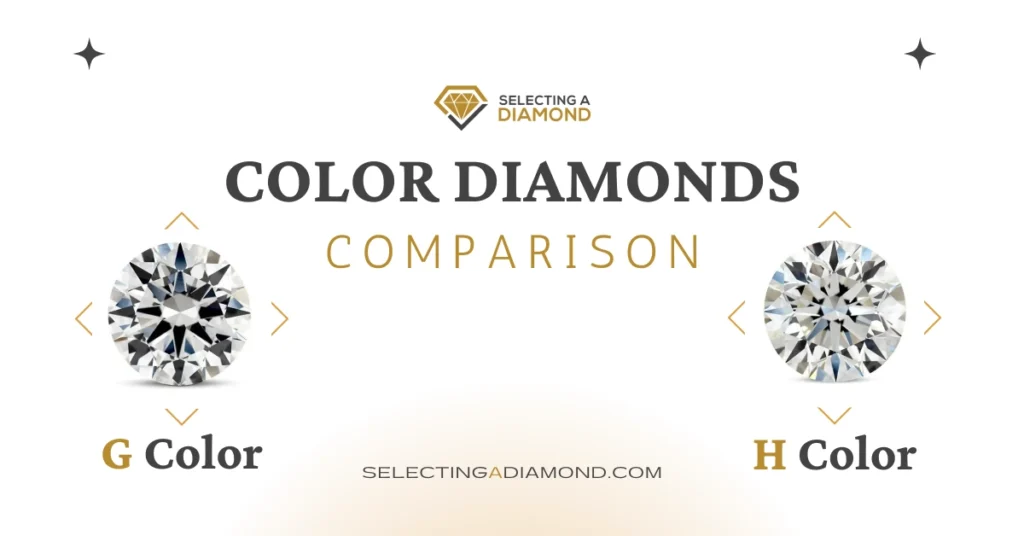

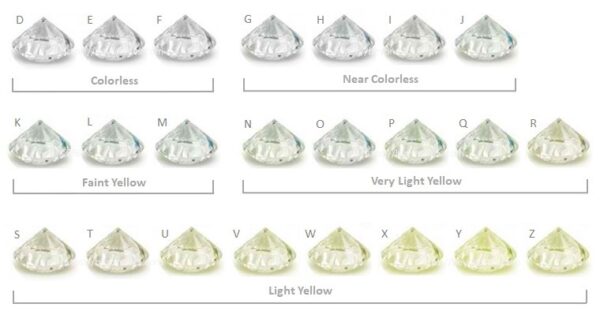
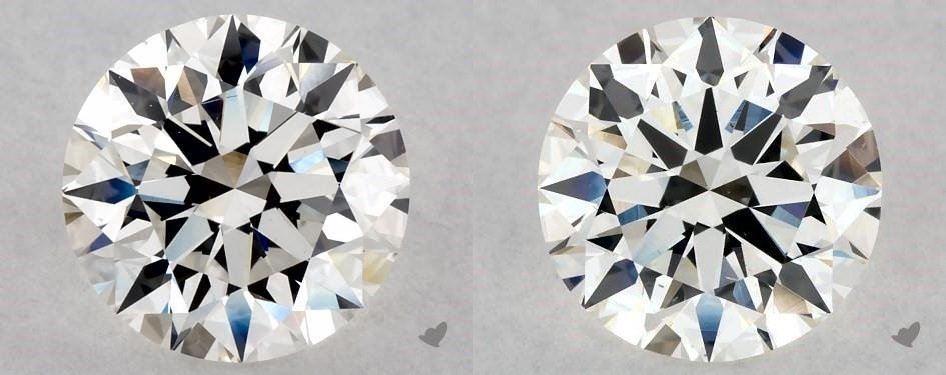



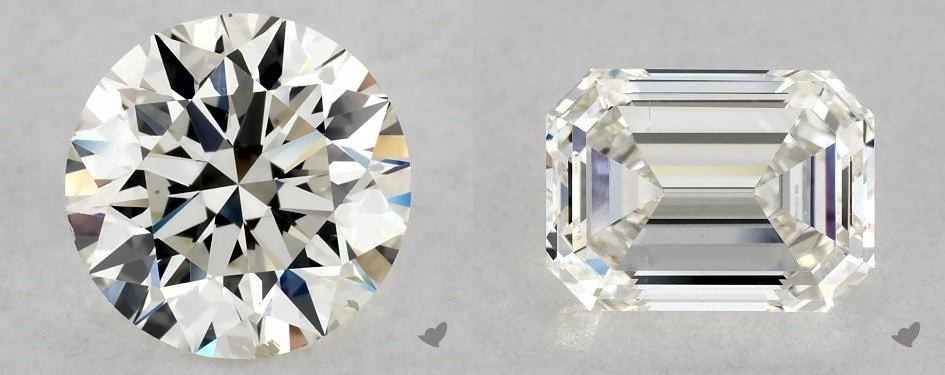 Both diamonds have color grade I, all characteristics are almost identical, here is
Both diamonds have color grade I, all characteristics are almost identical, here is 

